1993 BUICK REGAL brake
[x] Cancel search: brakePage 137 of 308
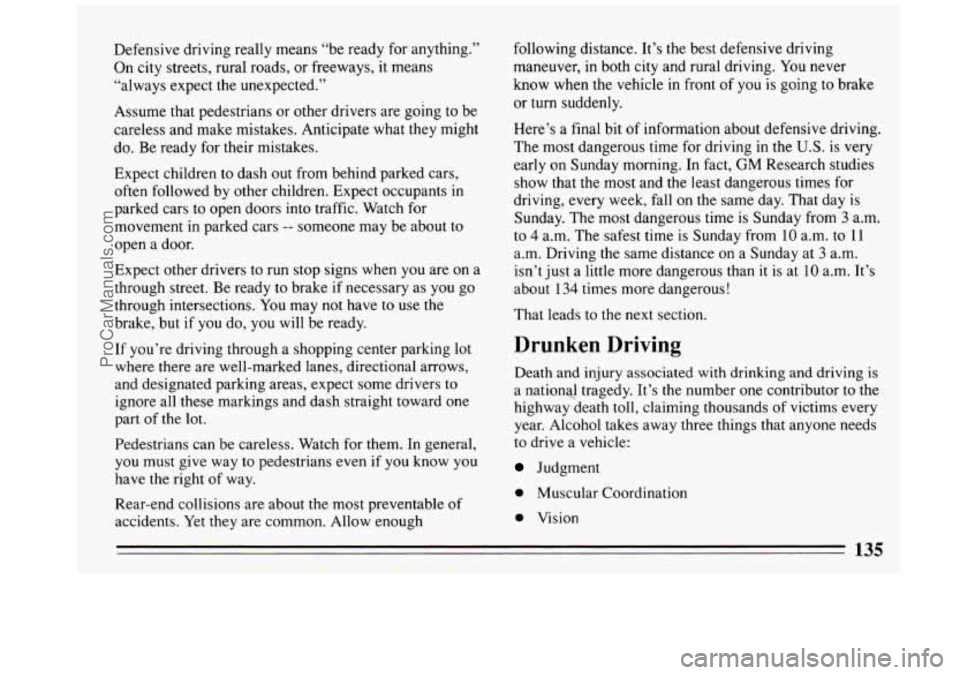
Defensive driving really means “be ready for anything.”
On city streets, rural roads, or freeways, it means
“always expect the unexpected.’’
Assume that pedestrians or other drivers are going to be
careless and make mistakes. Anticipate what they might
do. Be ready for their mistakes.
Expect children to dash out from behind.parked cars, often followed by other children. Expect occupants in
parked cars to open doors into traffic. Watch for
movement in parked cars
-- someone may be about to
open a door.
Expect other drivers to run stop signs when you are on a
through street. Be ready to brake if necessary as
you go
through intersections. You may not have to use the
brake, but if you do, you will be ready.
If you’re driving through a shopping center parking lot
where there are well-marked lanes, directional arrows,
and designated parking areas, expect some drivers
to
ignore all these markings and dash straight toward one
part
of the lot.
Pedestrians can be careless. Watch for them. In general,
you must give way to pedestrians even if
you know you
have the right of way.
Rear-end collisions are about
the most preventable of
accidents. Yet they are common. Allow enough following distance.
It’s the best defensive driving
maneuver, in both city and rural driving. You never
know when the vehicle in front of you is going to brake
or turn suddenly.
Here’s a final bit
of information about defensive driving.
The most dangerous time for driving in the
U.S. is very
early
on Sunday morning. In fact, GM Research studies
show that the most and the least dangerous times for
driving, every week, fall on the same day. That day is
Sunday. The most dangerous time is Sunday from
3 a.m.
to
4 a.m. The safest time is Sunday from 10 a.m. to 11
a.m. Driving the same distance
on a Sunday at 3 a.m.
isn’t just a little more dangerous than
it is at 10 a.m. It’s
about 134 times more dangerous!
That leads to the next section.
Drunken Driving
Death and injury associated with drinking and driving is
a national, tragedy. It’s the number one contributor
to the
highway death toll, claiming thousands of victims every
year. Alcohol takes away three things that anyone needs
to drive a vehicle:
Judgment
0 Muscular Coordination
0 Vision
135
ProCarManuals.com
Page 140 of 308
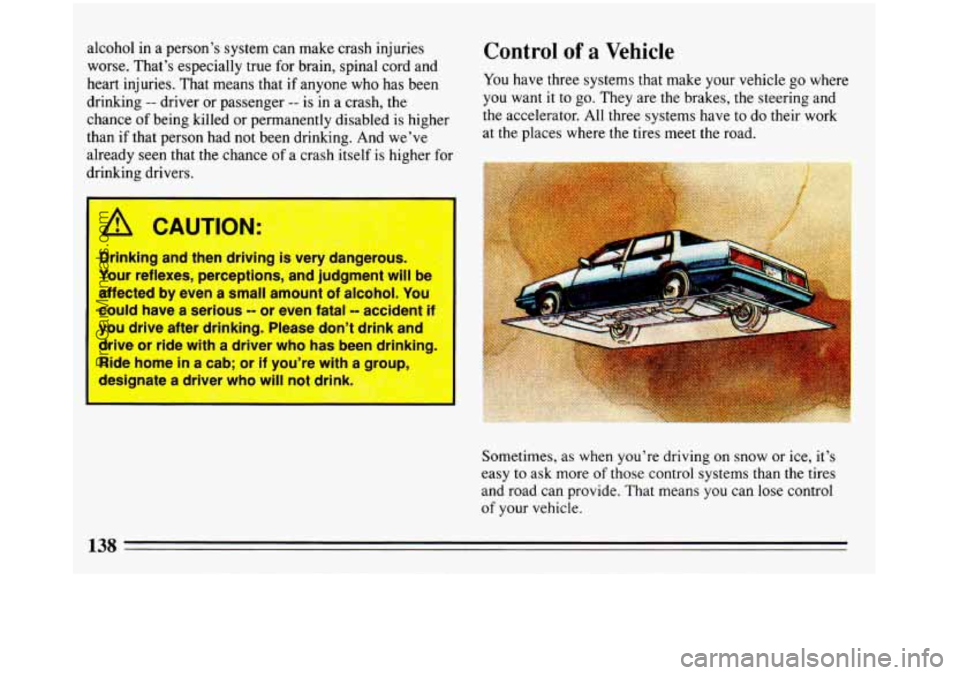
alcohol in a person’s system can make crash injuries
worse. That’s especially true for brain, spinal cord and
heart injuries. That means that if anyone who has been
drinking
-- driver or passenger -- is in a crash, the
chance of being killed or permanently disabled is higher
than if that person had not been drinking. And we’ve
already seen that the chance
of a crash itself is higher for
drinking drivers.
I A CAUTION:
Drinking and then driving is very dangerous.
Your reflexes, perceptions, and judgment will be
affected by even
a small amount of alcohol. You
~ could have a serious -- or even fatal -- accident if
you drive after drinking. Please don’t drink and
drive or ride with a driver who has been drinking.
Ride home
in a cab; or if you’re with a group,
designate a driver who will not drink:.
Control of a Vehicle
You have three systems that make your vehicle go where
you want it to
go. They are the brakes, the steering and
the accelerator. All three systems have to do their work
at the places where the tires meet the road.
Sometimes, as when you’re driving on snow or ice, it’s
easy to ask more
of those control systems than the tires
and road can provide. That means you can lose control
of your vehicle.
138
ProCarManuals.com
Page 141 of 308
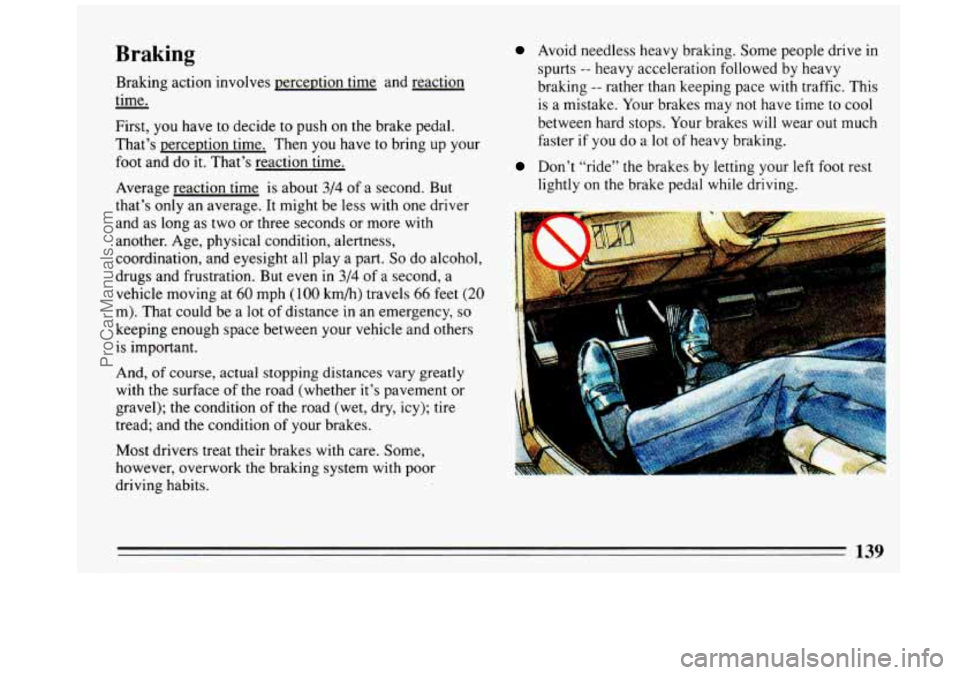
Braking
Braking action involves perception time and reaction
time.
First, you nave
to decide to push on the brake pedal.
That’s perception time. Then you have to bring up your
foot and do it. That’s reaction time.
-
Average reaction time is about 3/4 of a second. But
that’s only an average. It might be less with one driver
and as long
as two or three seconds or more with
another. Age, physical condition, alertness,
coordination, and eyesight all play a part.
So do alcohol,
drugs and frustration. But even in
3/4 of a second, a
vehicle moving at
60 mph (100 km/h) travels 66 feet (20
m). That could be a lot of distance in an emergency, so
keeping enough space between your vehicle and others
is important.
And,
of course, actual stopping distances vary greatly
with the surface
of the road (whether it’s pavement or
gravel); the condition of the road (wet, dry, icy); tire
tread; and
the condition of your brakes.
Most drivers treat their brakes with care. Some,
however, overwork the braking system with poor
driving habits.
Avoid needless heavy braking. Some people drive in
spurts -- heavy acceleration followed by heavy
braking
-- rather than keeping pace with traffic. This
is
a mistake. Your brakes may not have time to cool
between hard stops. Your brakes will wear out much
faster
if you do a lot of heavy braking.
Don’t “ride” the brakes by letting your left foot rest
lightly on the brake pedal while driving.
139
ProCarManuals.com
Page 142 of 308

“Riding” your brakes can cause th%m to overhed
to the point that they won’t work well. You might
not be able to stop your vehicle in time to avoid
an accident.
If you “ride” your brakes, they will
get
so hot they will require a lot of pedal force to,
SI0 lown. Avoid “rid a’’ the brak . ...4.L,::z .I_ : ,+ . ., ., ii: = ‘ :. 3 .
.. c. -.
I
“Riding” the brakes rs them out K%ch faster.
You would need costly brake replacement much
I
sooner th
economy.
I
If you keep pace with the traffic and allow realistic
following distances, you will eliminate a lot of
unnecessary braking. That means better braking and
longer brake life.
0 If your engine ever stops while you’re driving, brake
normally but don’t pump your brakes.
If you do, the
pedal may get harder to push down.
If your engine
stops, you will still have some power brake assist.
But you will
use it when you brake. Once the power
assist is used up, it may take longer to stop and the
brake pedal will be harder to push.
Anti-Lock Brakes (Option)
If your Buick has this system, your Buick has an
advanced electronic braking system that will help
prevent skidding.
If you have an anti-lock brake system (ABS), the brake
pedal will say
so. And this light on the instrument panel
will go
on when you start your vehicle.
When you start your vehicle
and begin to drive away,
you may hear a momentary motor or clicking noise. And
you may even notice that your brake pedal moves a little
while this is going on. This is the
ABS system testing
itself. If you have your foot
on the brake pedal, this
check won’t happen until the vehicle goes about
4 mph
(6 km/h) or until you take your foot off the brake pedal.
After an
ABS stop, you may hear a clicking noise the
next time the vehicle goes about 4 mph (6 km/h).
ProCarManuals.com
Page 143 of 308

If there’s a problem with the anti-lock brake system, the
anti-lock brake system warning light will stay
on or
flash.
See “Anti-lock Brake System Warning Light”
in the
Index.
I
Here’s how anti-lock works. Let’s say the road is wet.
You’re driving safely. Suddenly an animal jumps
out in
front of you.
You slam on the brakes. Here’s what happens with ABS.
A computer senses that wheels are slowing down. The
computer separately works the brakes at each front
wheel and at the rear wheels.
141
ProCarManuals.com
Page 144 of 308

The anti-lock system can change the brake pressure
faster than any driver could. The computer is
programmed to make the most
of available tire and road
conditions.
... ..
You can steer around the obstacle while braking hard.
As you brake, your computer keeps receiving updates on
wheel speed and controls braking pressure accordingly.
/A CAUTION:
Anti-lock doesn't change the time you need to
get your foot
up to the brake pedal. If you get too
close to the vehicle in front of you, you won't
have time to apply your
brakes if that vehicle
cvddenly
slows or stops. Always leave enough
luom up ahead to stop, even though you have
anti-lock brakes.
To Use Anti-Lock:
Don't pump the brakes. Just hold the brake pedal down
and
let anti-lock work for you. You also may hear a
clicking noise as
you accelerate after a hard stop.
Disc Brake Wear Indicators
Your Buick has four-wheel disc brakes.
Disc brake pads have built-in wear indicators that make
a high-pitched warning sound when
the brake pads are
worn and new pads are needed.
The sound may come
and
go or be heard all the time your vehicle is moving
(except when you are pushing on the brake pedal
firmly).
142
--
ProCarManuals.com
Page 145 of 308
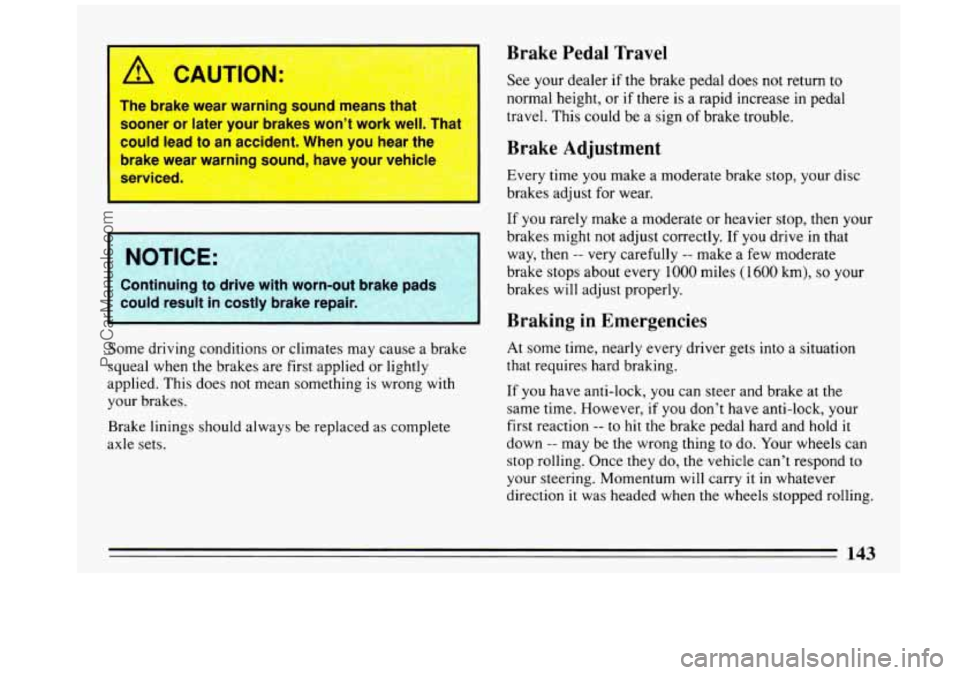
A LAUTION:
The brake wear warning sound means that
sooner or later your brakes won’t work well. Thal
could lead to an accident. When you hear the
brake wear warning sound, have your vehicle
serviced
NOTICE:
Continuing to drive with worn-out ‘-ake pat-
could result in costly brake repair
Some driving conditions or climates may cause a brake
squeal when the brakes are first applied or lightly
applied. This does
not mean something is wrong with
your brakes.
Brake linings should always be replaced as complete
axle sets.
Brake Pedal Travel
See your dealer if the brake pedal does not return to
normal height, or if there is a rapid increase in pedal
travel. This could be a sign
of brake trouble.
Brake Adjustment
Every time you make a moderate brake stop, your disc
brakes adjust for wear.
If you rarely make a moderate or heavier stop, then your
brakes might not adjust correctly.
If you drive in that
way, then
-- very carefully -- make a few moderate
brake stops about every
1000 miles (1600 km), so your
brakes will adjust properly.
Braking in Emergencies
At some time, nearly every driver gets into a situation
that requires hard braking.
If you have anti-lock, you can steer and brake at the
same time. However, if
you don’t have anti-lock, your
first reaction
-- to hit the brake pedal hard and hold it
down
-- may be the wrong thing to do. Your wheels can
stop rolling. Once
they do, the vehicle can’t respond to
your steering. Momentum will carry it in whatever
direction it was headed when the wheels stopped rolling.
ProCarManuals.com
Page 146 of 308
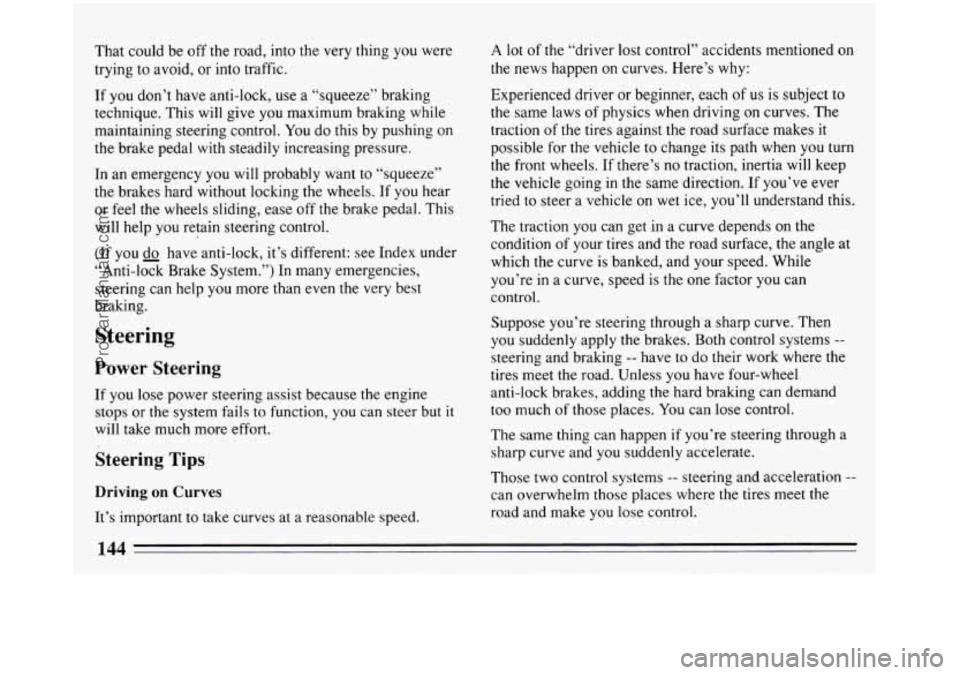
That could be off the road, into the very thing you were
trying to avoid,
or into traffic.
If you don’t have anti-lock, use
a “squeeze” braking
technique. This will give
you maximum braking while
maintaining steering control. You do this by pushing on
the brake pedal with steadily increasing pressure.
In an emergency
you will probably want to “squeeze”
the brakes hard without locking the wheels. If you hear
or feel the wheels sliding, ease off the brake pedal. This
will help you retain steering control.
(If
you & have anti-lock, it’s different: see Index under
“Anti-lock Brake System.”) In
many emergencies,
steering can help
you more than even the very best
braking.
Steering
Power Steering
If you lose power steering assist because the engine
stops or the system fails to function, you can steer but
it
will take much more effort.
Steering Tips
Driving on Curves
It’s important to take curves at a r8 easonable speed.
A lot of the “driver lost control” accidents mentioned on
the news happen
on curves. Here’s why:
Experienced driver or beginner, each of us is subject to
the same laws of physics when driving on curves. The
traction of the tires against the road surface makes it
possible for the vehicle to change its path when
you turn
the front wheels. If there’s
no traction, inertia will keep
the vehicle going in the same direction. If you’ve ever
tried to steer a vehicle on wet ice,
you’ll understand this.
The traction you can get in a curve depends on the
condition of your tires and the road surface, the angle at
which the curve is banked, and your speed. While
you’re in a curve, speed
is the one factor you can
control.
Suppose you’re steering through
a sharp curve. Then
you suddenly apply the brakes. Both control systems --
steering and braking -- have to do their work where the
tires meet the road. Unless you have four-wheel
anti-lock brakes, adding the hard braking can demand
too much
of those places. You can lose control.
The same thing can happen if you’re steering through a
sharp curve and you suddenly accelerate.
Those two control systems
-- steering and acceleration --
can overwhelm those places where the tires meet the
road and make you lose control.
144
ProCarManuals.com